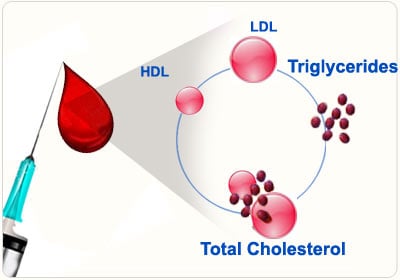- Dyslipidemia - (http://www.merckmanuals.com/professional/sec12/ch159/ch159b.html)
- Hypercholesterolemia Statistics For The U.S. - (https://ezinearticles.com/?Hypercholesterolemia-Statistics-For-The-U.S.&id=641689)
About
Lipids are substances like cholesterol and triglycerides that are derived from fats. While lipids are necessary for the cells of the body, excess lipids deposit in the wall of blood vessels and block the flow of blood. Lack of blood supply to vital organs like the heart and brain could result in serious complications like heart attack, stroke and even death.

Increased cholesterol levels are a major health issue in today’s world due to sedentary lifestyle and unhealthy diet.
It is estimated that over 105 million adults in the United States suffer from high cholesterol levels. Of these, more than 36 million adults have extremely high cholesterol levels.
Tests for Screening Lipid Profile
Excessive lipids in the blood deposit in the lining of blood vessels and lead to a condition called atherosclerosis. Atherosclerosis can result in a number of complications like heart disease, kidney disease and stroke. A patient with high lipids does not show any symptoms till he develops complications. Screening and early diagnosis of the condition can ensure early treatment and prevention of complications.
Which patients should undergo screening for lipid profile?
Screening tests for lipid profile are recommended for adults of 20 years or more. However, the age for starting screening for lipids varies with different recommendations. People less than 20 years of age may be screened if they suffer from the following risk factors for atherosclerosis:-
- Diabetes High blood pressure
- Obesity
- Premature heart disease or very high cholesterol level in immediate family
- In case of smokers.
How frequently should testing for lipid profile be done?
If the blood test is normal, it should be repeated every 5 years
What blood tests are carried out for lipids?
The following blood tests should be done after overnight fasting:
Total Cholesterol: This test measures all the lipids in the blood. A level of less than 200 mg/dL is desirable.
Serum Triglycerides: A high triglyceride level along with a high LDL-cholesterol level increases the chances of a person suffering from a heart attack. A level of less than 150 mg/dL is considered desirable.
HDL-cholesterol: HDL – cholesterol is often referred to as ‘good cholesterol.’ It plays a role in reducing atherosclerosis by removing excess fat from the blood. An HDL – cholesterol level between 40 and 60 mg/dL is considered normal.
LDL-cholesterol: LDL – cholesterol is referred to as bad cholesterol. It is primarily responsible for causing atherosclerosis. A level of less than 100 mg/dL is considered optimal (especially for people at a high risk for developing heart disease), though a level of less than 130 mg/dL is also considered normal.
Lp (a): Increased level of Lp (a) is associated with increased risk of heart disease. This test may be done in persons with an extensive history of heart disease in their family. A level of less than 14 mg/dL is usually considered safe.
Frequently Asked Questions
1. When should I consult a doctor regarding my cholesterol?
A consultation with your general physician is required if the tests are abnormal.
2. Why is HDL – cholesterol called good cholesterol?
HDL – cholesterol helps to remove excess lipids from the blood vessels and takes it to the liver for further processing. Thus it plays an important role in reducing atherosclerosis.
3. Is Lp (a) level routinely done with lipid profile?
No. This test may be done in persons with an extensive history of heart disease in their family.






